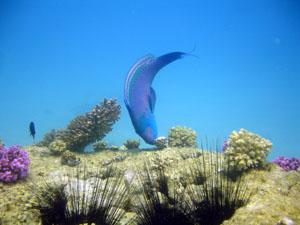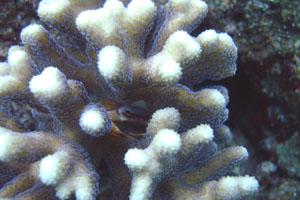Yael Horoszowski
This project consists of carrying out this revolutionary technique of transplanting nursery-grown colonies in a degraded reef in order to restore the reef of Eilat (Red Sea, Israel). Eilat’s coral reef is the world’s most northern reef.

Parrotfish grazing on favia.
The current state of coral reefs worldwide is alarming. Anthropogenic activities have significantly weakened the reefs' ability to cope with natural disturbances and to maintain themselves. Active restoration is now crucial to preserving this highly diversified and productive ecosystem. In the past, whole coral colonies or coral ramets were taken from healthy localities and transplanted into denuded areas. However, low survival rates of the transplants and the stress caused to donor colonies proved this method to be ineffective. In response, we suggest the "gardening coral reefs concept," a new method that adopts forest restoration techniques in the field of coral reef restoration. This method consists of two steps:

Trapezia crab in Stylophora.
1) generating and culturing minute coral fragments in an in situ nursery,
2) transplanting these colonies, when adult, in the degraded reef.
The transplantation of whole colonies instead of coral fragments substantially increases their ability to acclimate to the new environment. The nursery phase allows the initiation of the colony rearing from nubbins (1-10 polyps), which greatly reduces the stress caused to the donor colonies. It also enables the generation of thousands of new colonies which restore large zones in a short period of time.
This project consists of carrying out this revolutionary technique of transplanting nursery-grown colonies in a degraded reef in order to restore the reef of Eilat (Red Sea, Israel). Eilat’s coral reef is the world’s most northern reef. This reef, which was classified in the past among the richest and most bio-diversed reefs, has been in decline for the past forty years. New colonies generated in the coral nursery will be transferred by boat to the degraded site and transplanted on selected knolls. The transplanted corals will reinforce the poor local coral community, creating new spatial and ecological niches for marine invertebrates and fish, and thus, should simulate a whole coral reef associated fauna. Furthermore, they may also contribute and enhance the local larval pool by participating in the local coral reproduction. The settlement of new coral colonies could also increase due to the presence of the transplanted colonies since larvae tend to settle in areas where adult colonies already exist or on exposed coral skeleton.
The research will examine the survival rates of the transplants, their acclimatization in the new environment as well as the transplantation's influence on the local invertebrates and fish community.